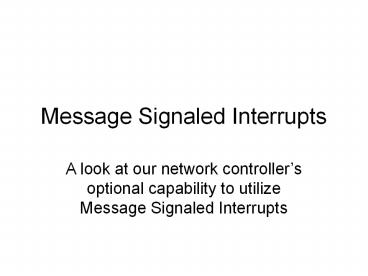Message Signaled Interrupts - PowerPoint PPT Presentation
Title:
Message Signaled Interrupts
Description:
Message Signaled Interrupts A look at our network controller s optional capability to utilize Message Signaled Interrupts The old way In order to appreciate ... – PowerPoint PPT presentation
Number of Views:192
Avg rating:3.0/5.0
Title: Message Signaled Interrupts
1
Message Signaled Interrupts
- A look at our network controllers optional
capability to utilize Message Signaled Interrupts
2
The old way
- In order to appreciate the benefits of using
Message Signaled Interrupts, lets first see how
devices do interrupts in a legacy PC
Interrupt Controller
I/O Device
main memory
CPU
IRQ2
I/O Device
ISR
IRR
INTR
EFLAGS
stack
ESP
IRQ1
I/O Device
IMR
INTA
EIP
APP
ISR
IRQ0
I/O Device
IVT
system bus
3
Multi-step communication
- A device signals that it needs CPU service
- The Interrupt Controller signals the CPU
- The CPU responds with two INTA cycles
- First INTA causes bit-changes in IRR and ISR
- Second INTA puts ID-number on system bus
- CPU uses ID-number to lookup IVT entry
- CPU saves minimum context on its stack, adjusts
eflags, and jumps to specified ISR
4
Faster, cheaper, and more
- Faster response to interrupts is possible if the
old multi-step communication scheme can be
replaced by a single-step protocol - Less expensive PCs can be manufactured if their
total number of signal pins and the physical
interconnections can be reduced - More devices can have their own private
interrupt(s) if signal lines arent required
5
The new way
- Message Signaling allows all the needed
information to arrive in a single package, and go
directly from a device to the CPU
main memory
I/O Device
CPU
ISR
EFLAGS
I/O Device
stack
I/O Device
ESP
EIP
APP
IVT
system bus
6
Implementation
- The customary PCI Configuration Space is modified
to accommodate three additional registers, which
collectively are known as the MSI Capability
Register Set - An MSI Control Register (16 bits)
- An MSI Address Register (32 bits/64 bits)
- An MSI Data Register (32 bits)
- (In fact these additions fit within a broader
scheme of so-called new capabilities)
7
PCI Command Register
15 10 9
8 7 6 5 4 3 2 1 0
Interrupt Disable Fast Back-to-Back Enable SERR
Enable Stepping Control Parity Error
Response VGA Palette Snoop Enable Memory Write
and Invalidate Enable Special Cycles Bus Master
Enable Memory Space Enable I/O Space Enable
8
PCI Status Register
15 14 13 12 11 10 9 8
7 6 5 4 3 0
Interrupt
Status Capabilities List
Reserved Reserved Fast Back-to-Back
Capable Master Data Parity Error
DEVSEL Timing Signaled
Target-Abort Received Target-Abort
Received Master-Abort
Signaled System Error Detected
Parity-Error
9
MSI Control Register
15
8 7 6 4 3 1
0
reserved
1
0 0 0
0 0 0
0
64-bit address capable (1yes, 0no)
multiple messages enable multiple messages
capable 000 1 message 001 2
messages 010 4 messages 011 8
messages 100 16 messages 101 32
messages 110 reserved 111 reserved
MSI Enable (1yes, 0no)
10
MSI Address Register
63
32
0 0 0 0 0 0 0 0 0 0 0 0 0 0 0 0 0 0 0 0 0 0 0 0 0
0 0 0 0 0 0 0
31 20 19 12
3 2 1 0
reserved
1 1 1 1 1 1 1 0 1 1 1 0
Destination ID
0 0
D M
R H
0xFEE
Specifies which processor in the system will be
the recipient the Message Signaled Interrupt
RH Redirection Hint (0No redirection,
1Utilize destination mode to determine message
recipient)
DM Destination Mode (0Physical,1Logical) Speci
fies how Destination ID will be interpreted
11
MSI Data Register
31
16
reserved
15 14 11 8
7 0
reserved
vector
Delivery Mode
T M
T L
Delivery Mode 000Fixed 001Lowes
t Priority 010SMI 011Reserved
100NMI 101INIT 110Reserved 111ExtINT
Trigger Level (1Assert, 0Deassert)
Trigger Mode (0Edge, 1Level)
12
Recall NICs interrupt registers
enum E1000_ICR 0x00C0, // Interrupt Cause
Read E1000_ICS 0x00C8, // Interrupt Cause
Set E1000_IMS 0x00D0, // Interrupt Mask
Set E1000_IMC 0x00D8, // Interrupt Mask
Clear
Registers usage You use Interrupt Mask Set
to selectively enable the NICs various
interrupts You use Interrupt Mask Clear to
selectively disable any of the NICs
interrupts You use Interrupt Cause Read to find
out which events have caused the NIC to generate
an interrupt (and then you can clear those bits
by writing to ICR) You can write to the
Interrupt Cause Set register to selectively
trigger the NIC to generate any of its various
interrupts -- provided they have been enabled
by bits being previously set in the NICs
Interrupt Mask Register.
13
Demo module msidemo.c
- This module installs an interrupt-handler for an
otherwise unused interrupt-vector - It initializes the MSI Capability Registers
residing in our Intel Pro1000 controllers PCI
Configuration Space, to enable the NIC to issue
Message Signaled Interrupts - It creates a pseudo-file (/proc/msidemo) that
triggers an interrupt when its read
14
Tools
- The unused interrupt-number is selected by
examining the settings in the IOAPICs
Redirection Table (e.g., for serial-UART) - Our NICs PCI Configuration Space can be viewed
by installing our 82573.c module and reading
its pseudo-file (/proc/82573) - We can watch interrupts being generated with our
smpwatch application-program































